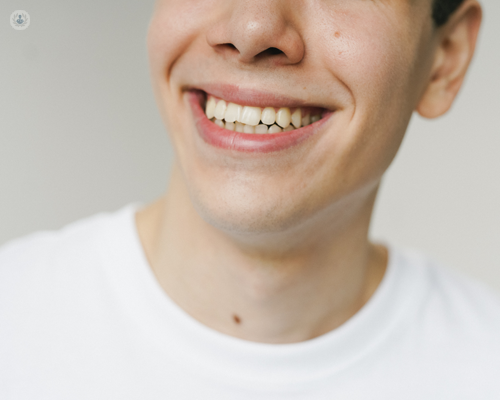All about temporomandibular joint replacement (TMJ)
Written by:There’s a variety of reasons why TMJ replacement surgery is required. Temporomandibular joint treatment to replace the jaw can take place due to an accident or jaw bone removal due to tumours, bone infection or arthritis.
Highly-experienced and respected oral and maxillofacial surgeon Professor Andrew Sidebottom speaks to Top Doctors about what’s involved in the TMJ replacement procedure for patients who are due to have this operation.

What is TMJ Replacement?
The damaged jaw joint is replaced to give a new base and a new articulation with the top of the mandible (lower jaw). The fossa is attached to the skull base and the articulating surface is made of ultra-high molecular weight polyethylene (like hip and knee replacements). The mandible portion is made of titanium with either a cobalt-chrome or titanium head.
When would I need a TMJ Replacement?
This procedure is an end stage operation to replace the joint when it has been irreparably damaged by arthritis, fusion or collapse. Usually, your surgeon will have tried to manage your condition with less aggressive treatments such as conservative management, arthroscopy and open surgery. When these alternatives have failed then a joint replacement may be considered.
There are specific guidelines established by BAOMS1 (the UK association of Oral and Maxillofacial Surgeons) and by NICE2 (the government body who investigate the appropriateness of procedures). (See references)
What does the procedure involve?
You will need to have a special type of CT scan which is sent to one of the joint manufacturing companies in the USA. You may also need to have tests for allergy to the components of the joint. A specific joint replacement will then be made which will fit you precisely. This process can take several months.
You will need some routine blood tests including checking your blood group and should be admitted on the day of the operation.
The operation takes about 90 minutes per side and you will remain in hospital for one to two days afterwards. It involves an cut in front of the ear, extending into the hairline and a second cut in the neck behind the jawline. These cuts are along the line of your skin creases and will fade with time. The sutures will be removed at five to seven days.
Your mouth will be wired together whilst you are asleep to prevent a disturbance in the way your teeth bite together. These wires will be removed before you wake up. The new joint will be fixed in position with screws into the cheek bone and your lower jaw. It is very uncommon to need a blood transfusion. A drain will be in the wound and is removed the following day. There will occasionally be the sound of squeaking or squelching when you move the joint, although this should not disturb you after a while.
What does it look and feel like afterwards?
You will be able to move your mouth in a straight line after the operation but movement sideways towards where the new joint is will be limited and if only one side is replaced your jaw may swing over to that side on opening. Swelling will reach a peak around two days and mostly be gone by two weeks, although there will be some minor swelling up to 6 months.
Your mouth opening should improve quite quickly afterwards and you will be encouraged to do mouth opening exercises immediately after the operation and regularly each day for several months. The pain will largely be managed by paracetamol and anti-inflammatory medicines and should start to improve quite quickly afterwards. A lot of your pre-existing pain should have gone by one year3,4. You should be able to comfortably eat a more solid diet, although it can take a few months for you to ‘get used to’ the new joint when eating as it may feel more ‘wooden’ biting together. I discourage the use of chewing gum or sticky and chewy foods.
You will not be able to see where the joint is and it does not set off alarms at airports.
What are the risks and benefits of the operation?
I have been doing TMJ replacement for over 20 years and have published outcomes in the international literature at one, 3, 5 and 10 years3,4,5,6. This shows better outcomes than hip and knee replacement, but is often in a younger age group7,8 as shown in UK-wide surveys. There have not been any cases of wearing out of the joint to date in 25 years.
Infection of the prosthesis (replacement) requires its removal and occurs in two to four per cent of cases. You should report for immediate antibiotics for any dental, skin or ear infection to try to prevent this. You will need antibiotics one hour before any invasive dental treatment including scaling of the teeth for the first two years after surgery. Formation of a bone fusion is uncommon unless you had one before and occurs in one per cent and requires revision surgery. The alternative to joint replacement is management of the pain from the joint with long-term medication.
The immediate risks of the procedure are small; temporary weakness of the movement of the forehead and upper eyelid or the corner of the mouth may occur in around 10 to fifteen per cent, and last for a few months. Permanent weakness is uncommon, around 1 per cent in my experience, and has only affected the forehead. Loss of sensation to the upper ear and temple is uncommon, but may be permanent. Loss of feeling in the skin over where the prosthesis lies is common and permanent but reduces with time. Loss of sensation to the lower lip and gums may occur but is usually transient.
Long term I have seen very few failures, but since they are made of the same materials as hip and knee replacement they will wear out in time, maybe 15 to 20 years. I have carried out over 300 joint replacements, the most recorded in Europe, and have the longest reported outcome series.
References
1. Sidebottom AJ. Guidelines for the replacement of the TMJ in the UK. Br J Oral Maxillofac Surg 46 (2008): 146-147
2. NICE Guidelines. IPG 500. Total prosthetic replacement of the temporomandibular joint. Guidance, September 2014
3. Sidebottom AJ, Gruber E. One-year prospective outcome analysis and complications following total replacement of the temporomandibular joint with the TMJ Concepts system. Br J Oral Maxillofac Surg 2013; 51 (5), 620-624
4. Quality of life outcomes one year after replacement of the temporomandibular joint using a modified SF36 questionnaire. B Gupta, N Ahmed, AJ Sidebottom. Br J Oral Maxillofac Surg 2020; 58(3):304-308
5. Gruber EA, McCullough J, Sidebottom AJ. Medium term outcomes and complications after total replacement of the temporomandibular joint. Prospective outcome analysis after 3 and 5 years. Br J Oral Maxillofac Surg. 2015; 53(5):412-5
6. Prospective study of the long-term outcomes and complications after total temporomandibular joint replacement: analysis at 10 years. A Rajkumar, A J Sidebottom Int J Oral Maxillofac Surg 2021; 51(5): 665-668
7. Idle MR, Lowe D, Rogers SN, Sidebottom AJ, Speculand B, Worrall SF. UK temporomandibular joint replacement database: report on baseline data. Br J Oral Maxillofac Surg. 2014 Mar;52(3):203-7
8. Elledge R, Attard A, Green J, Lowe D, Rogers SN, Sidebottom AJ, Speculand B. UK temporomandibular joint database: a report on one-year outcomes. Br J Oral Maxillofac Surg. 2017 Nov;55(9):927-931.
If you’re looking for an expert in jaw replacement surgery, Professor Andrew Sidebottom is one of only eight surgeons in the UK who provides over ten TMJ Joint Replacement procedures yearly. Arrange an appointment with this leading consultant oral and maxillofacial surgeon via his Top Doctors profile.


